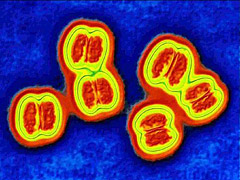About meningitis
Neisseria meningitidis is a leading cause of bacterial meningitis. |
A much-feared disease
Meningitis is an infection of the meninges, the thin lining that surrounds the brain and spinal cord. It is sometimes referred to as spinal meningitis.
The most common causes of meningitis are viral and bacterial; fungal and parasitic infections are much less frequent. Knowing whether meningitis is caused by a virus or bacterium is important because the severity of the disease and its treatment depend on the type of infection:
- Viral meningitis is generally benign and resolves without specific treatment.
- Bacterial meningitis is much more serious because its onset is rapid and the infection is associated with a significant risk of death. Bacterial meningitis may also result in mental retardation, deafness, epilepsy, or necrosis leading to limb amputation. It is important to know which type of bacteria is causing the meningitis because antibiotics can prevent some types from spreading and infecting other people.
Before the 1990s, Haemophilus influenzae type b (Hib) was the leading cause of bacterial meningitis, but new vaccines given to all children as part of their routine immunizations have reduced the occurrence of invasive disease due to H. influenzae. Today, Streptococcus pneumoniae and Neisseria meningitidis (meningococcus) are the leading causes of bacterial meningitis.
Photo: Public Library of Science (PLoS).

